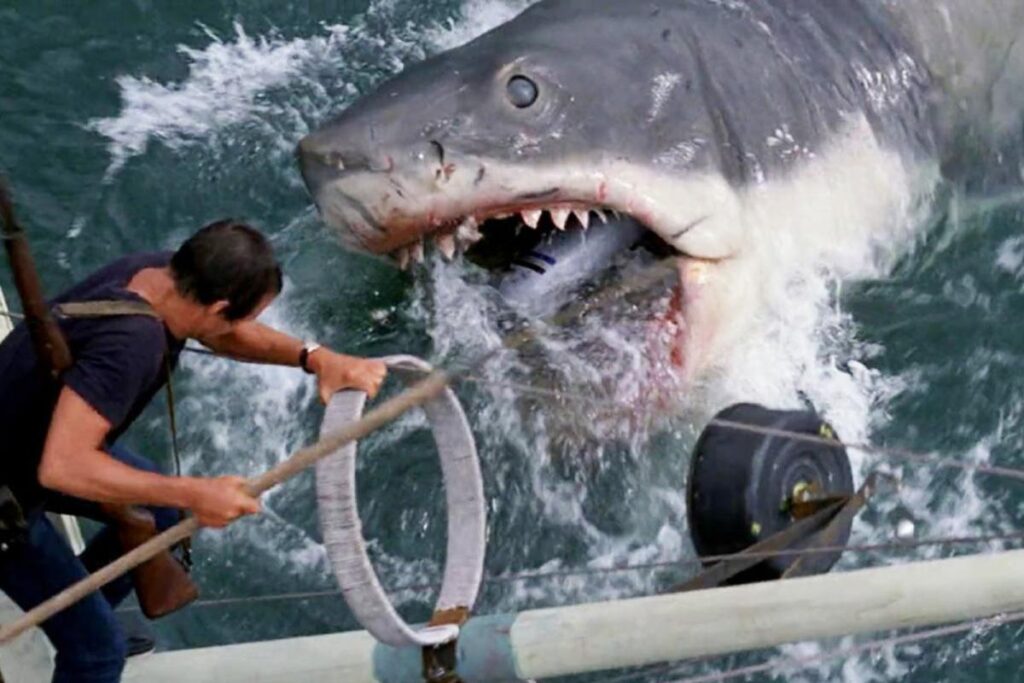Steven Spielberg’s 1975 movie Jaws has a number of different reputations to maintain as it turns 50 this summer. First and perhaps foremost, it’s considered the first modern blockbuster, one that essentially reinvented how Hollywood saw the summer-movie season into the big-grossing model that perpetuates to this day. It’s also a high-water mark for the shark-thriller genre, a landmark in Spielberg’s career, and one of the earliest films to be shot so heavily on the actual ocean. But how does it hold up as a movie, rather than a piece of cinema history? To celebrate the film’s 50th anniversary, Peacock is currently streaming all four of the Jaws movies, giving audiences a new chance to check them out for themselves.
JAWS: STREAM IT OR SKIP IT?
The Gist: So yeah, you may have heard about this one before. Based on Peter Benchley’s 1974 bestseller, Jaws opens with a shark attack off the coast of the (fictional) New England beach town Amity Island. A young woman is killed, and police chief Martin Brody (Roy Scheider) wants to close down the beach. But the mayor of Amity refuses to accept this during their busy and lucrative summer season, leading to more attacks from a shark that Brody comes to realize is unusually large and fierce. With the help of shark-hunter Quint (Robert Shaw) and marine biologist Hooper (Richard Dreyfuss), Brody endeavors to track and kill the creature in question.
What Will It Remind You Of?: Well, if you’ve seen any shark movies from the 50 years since Jaws, it’ll probably remind you of those, because they’re mostly operating within this movie’s shadow. And if you’re well-versed in cinema history but somehow haven’t seen Jaws, the film’s three-men-on-a-ship material may remind you of Howard Hawks pictures, and there’s a bit of westerns in particular to its story of three men confronting nature.
Performance Worth Watching: The not-so-secret to Jaws is that the shark, shown sparingly due to a malfunctioning animatronic, is the least interesting thing about it. The movie works as well as it does because Spielberg directs the hell out of it, and because Scheider, Dreyfuss, and Shaw make such an endearingly mismatched yet perfectly complemented team, mixing pragmatism, smarts, and crusty experience. The shark attacks are grabby and wonderfully staged, but the dialogue scenes between the three leads sustain the movie and make it feel like more than a theme-park ride.
Sex and Skin: The first victim is a skinny-dipping young woman, something that unexpectedly ties the often sex-light Spielberg to the then-nascent traditions of slasher pictures.
Memorable Dialogue: Well, there’s “you’re gonna need a bigger boat,” which has been quoted to death but still kills in-context. But Quint has plenty more, including a whole-ass monologue about his experiences on the U.S.S. Indianapolis, a real-life boat that was sunk and whose initial survivors were subjected to horrific shark attacks.
Our Take: I think this Spielberg kid may have something! Seriously, it’s not something that can be said about every chart-topping summer movie from the past 50 years, but sure as heck can about this one: There’s a reason Jaws made so much money. It’s because Spielberg alchemized the old-fashioned pleasures of a men-on-a-mission movie with creature-feature horror and superb instincts in suspense filmmaking, which means that isn’t just a moment or two from Jaws that everyone remembers; there are multiple scenes, lines, and shots that have become, for lack of a less overused word, iconic.
It would be easy, then, for Jaws to become mostly about its own iconography over the years. But it still has thematic resonance, thanks to its profit-obsessed mayor who near-literally throws his citizens to the sharks rather than risk a dip in annual tourism revenue, as well as the timeless conflict between the concerns of man and the unknowable, untamable ways of nature. The movie also has a sense of place and time that, unfortunately, tended to drain out of family-friendly blockbusters over time. Something that makes Jaws a particularly apt kick-off to the summer-blockbuster era that never ended is its seasonality. This the rare summer blockbuster that really feels like summer: It’s based on a beach-read bestseller; it’s set in a tourist town (shot on location in Martha’s Vineyard) and on the ocean; and conceptually, the whole thing feels like a particular summer-vacation nightmare, with a some camp-friends camaraderie thrown in via the Brody/Quint/Hooper relationship. 50 years on, Jaws may no longer be the biggest movie ever made, but it looks even more like a true American classic.
Our Call: Do you have to ask? If you haven’t seen it, and maybe even if you already have, STREAM IT.
Jesse Hassenger (@rockmarooned) is a writer living in Brooklyn podcasting at www.sportsalcohol.com. He’s a regular contributor to The A.V. Club, Polygon, and The Week, among others.
Read the full article here








